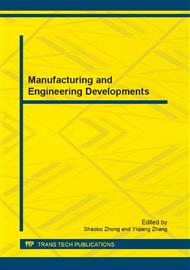[1]
O. Amidi, 1996, An autonomous vision-guided helicopter, Ph.D. dissertation, Robotics Institute, Carnegie Mellon University.
Google Scholar
[2]
O. Amidi, T. Kanade, and K. Fujita, 1999, A Visual Odometer for Autonomous Helicopter Flight, Robotics and Autonomous Systems, 28, 185-193.
DOI: 10.1016/s0921-8890(99)00016-0
Google Scholar
[3]
Saripalli S, MontgomeryJ. F, Sukhatme, G. S, 2002, Vision-based autonomous landing of an unmanned aerial vehicle, IEEE International Conference on Robotics and Automation, 3, 2799 – 2804.
DOI: 10.1109/robot.2002.1013656
Google Scholar
[4]
Srikanth Saripalli and Gaurav S Sukhatme, 2006, Landing on a Moving Target using an Autonomous Helicopter, Field and service robotics, 24, 277-286.
DOI: 10.1007/10991459_27
Google Scholar
[5]
Srikanth Saripalli, James F. Montgomery, and Gaurav S. Sukhatme, 2003, Visually-Guided Landing of an Unmanned Aerial Vehicle, IEEE Transactions on Robotics and Automation, 19/3, 371-381.
DOI: 10.1109/tra.2003.810239
Google Scholar
[6]
Lin Feng, Chen Ben M, Lum Kai Yew, 2007, Integration Implementation of a low cost vision based UAV Tracking System, The 26th Chinese Control Conference, 731-736.
DOI: 10.1109/chicc.2006.4347399
Google Scholar
[7]
Alison A. Proctor¤ and Eric N. Johnsony. 2005, Vision-only Approach and Landing, AIAA Guidance, Navigation, and Control Conference and Exhibit, 1-10.
DOI: 10.2514/6.2005-5871
Google Scholar
[8]
Yang Fan, Shi Haiqing, Wang Hong, 2008, A Vision-Based Algorithm for Landing Unmanned Aerial Vehicles". 2008 International Conference on Computer Science and Software Engineering, 1, 993-996.
DOI: 10.1109/csse.2008.309
Google Scholar
[9]
David G. Lowe, 2004, Distinctive image features from scale-invariant keypoints, International Journal of Computer Vision, 60/ 2, 91-110.
DOI: 10.1023/b:visi.0000029664.99615.94
Google Scholar
[10]
I.F. Mondragon, P. Campoy, J.F. Correa, L. Mejias, 2007, Visual Model Feature Tracking for UAV Control, IEEE International Symposium on Intelligent Signal Processing, 1-6.
DOI: 10.1109/wisp.2007.4447629
Google Scholar
[11]
Yuping Lin, Qian Yu, Gerard Medioni, 2007, Map-Enhanced UAV Image Sequence Registration, Proceedings of the 8th IEEE Workshop on Applications of Computer Vision, 15-21.
DOI: 10.1109/wacv.2007.42
Google Scholar
[12]
Samer M. Abdallah, Daniel C. Asmar and John S. Zelek, 2007, A Benchmark for Outdoor Vision SLAM Systems, Journal of Field Robotics, 24/1-2, 145-165.
DOI: 10.1002/rob.20180
Google Scholar
[13]
Todd Templeton, David Hyunchul Shim, Christopher Geyer, and S. Shankar Sastry, 2007, Autonomous Vision-based Landing and Terrain Mapping Using an MPC-controlled Unmanned Rotorcraft, IEEE International Conference Robotics and Automation, 1349-1356.
DOI: 10.1109/robot.2007.363172
Google Scholar
[14]
Diomidis Katzourakis, Nikos I. Vitzilaios, and Nikos C. Tsourveloudis, 2009, Vision Aided Navigation for Unmanned Helicopters, 17th Mediterranean Conference on Control & Automation, 1245-1250.
DOI: 10.1109/med.2009.5164717
Google Scholar
[15]
Y. Ke and R. Sukthankar, 2004, PCA-SIFT: A more distinctive representation for local image descriptors, IEEE Conference on Computer Vision and Pattern Recognition, 2, 506–513.
DOI: 10.1109/cvpr.2004.1315206
Google Scholar
[16]
Herbert Bay, Tinne Tuytelaars, Luc Van Gool, 2006, SURF: Speeded Up Robust Features, Proceedings of the 9th European Conference on Computer Vision, 3951, 404-417.
DOI: 10.1007/11744023_32
Google Scholar
[17]
Y. Cheng, 1995, Mean shift, mode seeking, and clustering, IEEE Transaction on Pattern Analysis and Machine Intelligence, 17, 790-799.
DOI: 10.1109/34.400568
Google Scholar
[18]
Information on: http: /www. vision. ee. ethz. ch/~surf.
Google Scholar
[19]
Saripalli, S, Montgomery, J. F, Sukhatme, G. S, 2002, Vision-based autonomous landing of an unmanned aerial vehicle, IEEE International Conference on Robotics and Automation, 3, 2799 – 2804.
DOI: 10.1109/robot.2002.1013656
Google Scholar
[20]
Yang Fan, Shi Haiqing, Wang Hong, 2008, A Vision-Based Algorithm for Landing Unmanned Aerial Vehicles, International Conference on Computer Science and Software Engineering, 1, 993-996.
DOI: 10.1109/csse.2008.309
Google Scholar
[21]
Andrea Cesetti, Emanuele Frontoni, Adriano Mancini, Primo Zingaretti, Sauro Longhi, 2009, Vision-based Autonomous Navigation and Landing of an Unmanned Aerial Vehicle using Natural Landmarks, 17th Mediterranean Conference on Control & Automation, 910-915.
DOI: 10.1109/med.2009.5164661
Google Scholar


